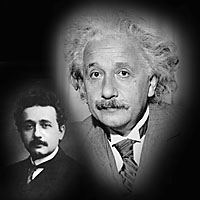 | Albert Einstein drew on earlier work by Max Planck to outline the particle properties of light. This image is from the poster for the lecture. |
To mark the 100th anniversary of the publication of Albert Einstein's famous 1905 paper on the particle properties of light, Professor Douglas Stone will present the Yale Engineering Dean's Distinguished Lecture on the topic "Genius and Genius2: Planck, Einstein and the Birth of Quantum Theory."
Stone will argue that Albert Einstein, arguably the most famous scientist in history, is underappreciated for his contributions to physics.
Stone is the Carl A. Morse Professor of Applied Physics, director of the Division of Natural Sciences and professor of physics at Yale. His own research is an outgrowth of Einstein's work, focusing on theoretical condensed matter and optical physics, quantum transport phenomena in disordered media, mesoscopic electron physics, quantum and wave chaos, quantum measurement, and quantum computing.
"We are fortunate to have in Professor Stone a unique scientist-scholar to enlighten and enthrall us with his insights on Albert Einstein's unequaled contributions to science," says Paul A. Fleury, dean of the Faculty of Engineering.
The lecture will take place on Tuesday, Nov. 15, at 4 p.m. in Davies Auditorium, 15 Prospect St. A reception will follow. The event is free, and the public is invited.
In 1900, German physicist Max Planck proposed that the energy of mechanical systems was not continuous but was quantized to indivisible units of magnitude determined by the constant of nature, h, which now bears his name. Planck was forced to this radical hypothesis in order to explain the nature of thermal radiation, a central problem in the physics of the time.
The revolutionary and fundamental nature of Planck's quantum hypothesis remained unappreciated until a young patent clerk, Albert Einstein, began to unlock its meaning with his 1905 paper on the particle properties of light. That paper claimed that, in its interaction with matter, light behaved as a particle (what is now referred to as a photon). The idea was revolutionary, and the photon concept was not fully accepted in physics for the next 18 years.
T H I S
Lecture will pay homage to Albert Einstein W E E K ' S
W E E K ' S S T O R I E S
S T O R I E S![]()
 Yale opens new International Center
Yale opens new International Center![]()
![]()
 Community invited to center's Open House
Community invited to center's Open House![]()
![]()
 New program to offer joint M.B.A./Ph.D.
New program to offer joint M.B.A./Ph.D.![]()
![]()
 Peabody will create science curriculum with NIH grant
Peabody will create science curriculum with NIH grant![]()
![]()
 'Al Franken Show' to be broadcast from Woolsey Hall
'Al Franken Show' to be broadcast from Woolsey Hall![]()
![]()
 Famed singer tells of his determination to voice his views
Famed singer tells of his determination to voice his views![]()
![]()
 Economist says climate change hits the poor hardest
Economist says climate change hits the poor hardest![]()
![]()
 Parasite that causes Sleeping Sickness . . .
Parasite that causes Sleeping Sickness . . .![]()
![]()
 'Safe in Hell' takes devilish look at Salem witch trials
'Safe in Hell' takes devilish look at Salem witch trials![]()
![]()
 Innovative architectural visions showcased in 'Transcending Type'
Innovative architectural visions showcased in 'Transcending Type'![]()
![]()
 Renovated community Eye Clinic celebrates with an open house
Renovated community Eye Clinic celebrates with an open house![]()
![]()
 Departments, donors to win prizes at United Way celebration
Departments, donors to win prizes at United Way celebration![]()
![]()
 Additions to Yale Cancer Center will boost clinical care
Additions to Yale Cancer Center will boost clinical care![]()
![]()
 Coast-to-coast run will raise funds for center for cancer survivors
Coast-to-coast run will raise funds for center for cancer survivors![]()
![]()
 Panel to discuss 'The Media and Corporate Corruption'
Panel to discuss 'The Media and Corporate Corruption'![]()
![]()
 Lecture will pay homage to Albert Einstein
Lecture will pay homage to Albert Einstein![]()
![]()
 Auction to help alleviate hunger, homelessness
Auction to help alleviate hunger, homelessness![]()
![]()
 Library hosts shows on printing process and preservation
Library hosts shows on printing process and preservation![]()
![]()
 Women's healthcare challenges to be topic of forum
Women's healthcare challenges to be topic of forum![]()
![]()
 Concert will pay tribute to the memory of Divinity School alumnus
Concert will pay tribute to the memory of Divinity School alumnus![]()
![]()
 Week celebrates importance of international education
Week celebrates importance of international education![]()
![]()
 F&ES faculty member honored for research on rivers
F&ES faculty member honored for research on rivers![]()
![]()
 Researcher Mark Johnson wins Plyler Prize . . .
Researcher Mark Johnson wins Plyler Prize . . .![]()
![]()
 'A Colony of Citizens' wins Douglass Prize for work on slavery
'A Colony of Citizens' wins Douglass Prize for work on slavery![]()
![]()
 Golden days
Golden days![]()
![]()
 Yale Books in Brief
Yale Books in Brief![]()
![]()
 Campus Notes
Campus Notes![]()
Bulletin Home |
| Visiting on Campus
Visiting on Campus |
| Calendar of Events
Calendar of Events |
| In the News
In the News![]()
Bulletin Board |
| Classified Ads
Classified Ads |
| Search Archives
Search Archives |
| Deadlines
Deadlines![]()
Bulletin Staff |
| Public Affairs
Public Affairs |
| News Releases
News Releases |
| E-Mail Us
E-Mail Us |
| Yale Home
Yale Home